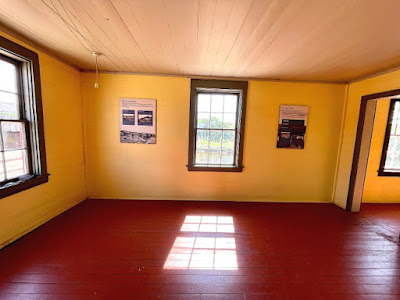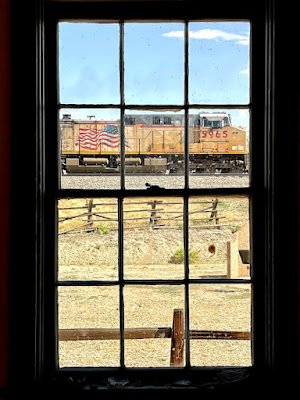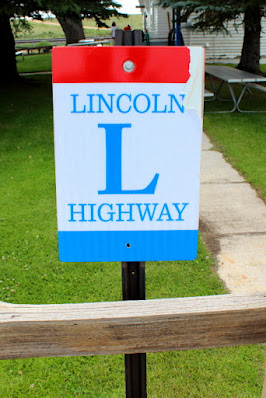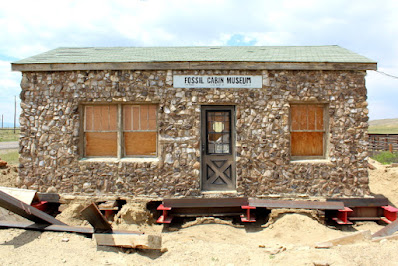 |
| Picture by Kolohe |
We could not find the historic Wyoming Frontier Prison in Rawlins, so we asked a guy driving a Cadillac. He was not helpful because he did not even know which direction he was going. Fortunately, we had a GPS unit with us.
When we visited the Prison we discovered that there were some interesting people that had been incarcerated there.
Hattie LaPierre was found guilty of shooting Frank McKinney, aka Harry Black, in cold blood. Hattie said that Frank had threatened her life and her actions were based in fear and self-defense. The jury did not buy her story. Hattie was convicted of manslaughter, but she only served one year in prison.
Bill Carlisle was Wyoming's last great train robber and was known as the Gentleman Bandit because he refused to rob women and children. In 1916 he was captured, tried, and sentenced to life in prison. However, three years later he escaped and robbed another train. He was captured and again returned to prison. Seventeen years later he was released from prison and became a model citizen. He married a nurse that treated him in prison, became a successful businessman, and received a full pardon by the Governor.
Facilities at the prison were not the most appealing. |
| Picture by Kolohe |
Fort Fred Steele was built in 1868 to protect workers on the transcontinental railroad from Indian attacks. Immediately after the fort was completed, Generals Ulysses S. Grant and William T. Sherman, accompanied by an entourage of military people, stopped at the new fort while on a trip west and named it in honor of Civil War Hero Major-General Frederick Steele. The Fort soon became a major military stop for the railroad because the railroad made it possible to quickly move troops and heavy equipment from Fort Steele to other locations.
After Fort Steele was completed, the town of Benton quickly sprang up just outside of the fort to supply entertainment for railroad crews and military troops. The town had 25 saloons and 5 dance halls. Benton soon became known as "Hell on Wheels" because the closest law enforcement was 100 miles away in Cheyenne. During the town's boom days there were 100 murders in 90 days.
A few of the original structures at Fort Fred Steel still exist today and are now protected by the State of Wyoming Division of State Parks & Historic Sites.
The Post Trader's House was constructed in the early 1880s using lime-grout, an early form of concrete, mixed with stone aggregate, sand and quicklime. It is one of the last remaining line-grout structures of its kind still standing in the United States. Part of the original house has been restored and is now used as the Fort's Visitor Center.
 |
| Picture by Kolohe |
 |
| Picture by Kolohe |
The Bridge Tender's House was built on the banks of the North Platte River. It was one of the few private buildings allowed on the Fort.
From windows in the Bridge Tender's house there are clear views of the railroad tracks and the North Platte River. The original bridge was replaced with a more modern design directly north of the original railroad grade that is still visible.
 |
| Picture by Kolohe |
 |
| Picture by Kolohe |
Five Enlisted Mens' Barracks and the Parade Grounds were located adjacent to the River on the north side of the railroad tracks. None of the barracks still exist.
The Parade Grounds were used for training, parades, and community socials. Located on the north side of the Parade Grounds are the Quartermaster's building and a one-room school.
 |
| Picture by Kolohe |
The Powder Magazine was located away from all other buildings and had very thick walls and a week roof to direct any explosions up, not out.
The community of Hanna is located along the Old Lincoln Highway as it runs northeast from Fort Fred Steele.
Hanna was founded as a coal supply for the Union Pacific Railroad and much of the old town is build on top of the former Hanna No. 4 Mine workings.
In 1903 an underground explosion blocked the main mine entrance and 169 of the 215 miners died. The town's cemetery was too small to bury all of the miners, so a new cemetery was started three miles from town.
There are a number of monuments in and around the town, honoring miners and military veterans. There is also a rare rotary snowplow locomotive at the Veterans Memorial.
 |
| Picture by Kolohe |
Continuing along the Old Lincoln Highway we came to Medicine Bow, "Home of the World Champion Bull Chip Throw." (The 2021 World Champion from Chadron, Nebraska, threw a Bull Chip 147-feet, which was not even close to the all-time record of 204-feet set in 1990. Participation in 2021 event was reported to be light due to COVID-19.)
 |
| Picture by Kolohe |
The Medicine Bow Train Depot has been converted to a museum and has an amazing collection of memorabilia for a small town (population 284). The station manager was still sitting at his desk watching for trains - and one came by while we were standing outside. (Sophia tried to catch a small bunny in the front yard, but it was too fast for her.)
 |
| Picture by Kolohe |
 |
| Picture by Kolohe |
 |
| Picture by Kolohe |
Located on the museum property is a monument to Owen Wister and a log cabin where we had the opportunity to visit with Owen about his western novels. Owen was wearing his COVID-19 mask, but he looked a little ragged.
Owen was fascinated by the West and gave up his law career to become a writer in the late 1800s. In 1902 he published The Virginian, which is regarded as being the first published cowboy novel. The book was reprinted fourteen times in eight months. Much of The Virginian, and subsequent television series by the same name, were set in or near Medicine Bow. The Virginian Hotel is located directly across the street from the museum.
The Old Lincoln Highway runs by the museum and located on the front lawn of the museum is a George A. Wyman 1st Across Waypoint Marker. In 1903 Wyman was the first person to make a transcontinental crossing of the United States by a motor vehicle. He made the crossing from San Francisco to New Your City in 51 days riding a California Motor Company motor cycle, finishing 20 days before Dr. Horatio Jackson, the first person to cross the continent by automobile.


Located about five miles east of town is the Fossil Cabin Museum that is currently being moved to the museum grounds in Medicine Bow. The building has the distinction of being the Oldest Building in the World because it is constructed from 5,796 dinosaur bones that were excavated at nearby Como Bluff. When first constructed, the building was used as a gas station along the Old Lincoln Highway. Over the years, the building has been known as "Como Bluff Dinosaurium," "The World's Oldest Cabin," "The Creation Museum," and "The Building That Used To Walk."
This is also the area where Butch Cassidy and the Wild Bunch robbed a train. During the robbery the Union Pacific express messenger refused to open the safe, so dynamite was place on the safe's door. The dynamite was insufficient to blow open the door, so a much larger charge was used the second time. Apparently, Butch miscalculated the amount of dynamite needed to open the safe's door. The second time the safe was not only blown open, but the sides and roof of the box car were blown off and money was scattered all over the surrounding area.
 |
| Picture by Kolohe |
Arlington was founded in 1860 as a commercial stage stop on the Overland Trail and soon became a home station as well as an entertainment center for locals and travelers. There was a dance hall, saloon, general store, post office, school, and blacksmith shop. A number of buildings are still standing and the entire Rock Creek Crossing area is listed as a Historic District on the National Register of Historic Places.
 |
| Picture by Kolohe |














































No comments:
Post a Comment